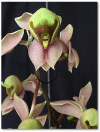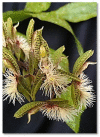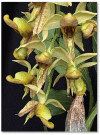Volatile Constituents from Catasetum (Orchidaceae) Species with Occurrence in the Brazilian Amazon
- PMID: 36840051
- PMCID: PMC9959621
- DOI: 10.3390/plants12040703
Volatile Constituents from Catasetum (Orchidaceae) Species with Occurrence in the Brazilian Amazon
Abstract
Background: Catasetum Rich. ex Kunth is a genus of Neotropical orchids distributed in Central and South American regions. In the Brazilian Amazon, there are more than 60 species of Catasetum. The floral aromas of orchids are little known, particularly of Catasetum species. This work aimed to analyze the chemical constituents of the volatile concentrates of eight Catasetum specimens from the Amazon: C. alatum (1), C. albovirens (2), C. barbatum (1), C. ciliatum (2), C. galeritum (1), and C. gnomus (1).
Methods: Gas chromatography (GC) and gas chromatography-mass spectrometry (GC-MS) analyzed and identified the constituents of the volatile concentrates, and principal component analysis (PCA) and hierarchical cluster analysis (HCA) were used in the multivariate statistical analysis.
Results: The Catasetum main constituents in descending order and above 10% were trans-geranylgeraniol, 1,4-dimethoxybenzene, linalool, 2-phenylethyl acetate, geraniol, 7-epi-1,2-dehydro-sesquicineole, 1,8-cineole, benzyl acetate, limonene, methyl salicylate, (E)-β-farnesene, anisyl butyrate, cis-carvone oxide, cadin-4-en-10-ol, indole, α-pinene, and δ-cadinene.
Conclusions: Multivariate statistical analysis of Catasetum species showed that C. barbatum, C. albovirens, and C. gnomus are distinct from the other studied species, while C. alatum, C. ciliatum, and C. galeritum presented the same primary classes of compounds. These results contribute to a better understanding of the genus Catasetum chemotaxonomy.
Keywords: 1,4-dimethoxybenzene; 2-phenylethyl acetate; 7-epi-1,2-dehydro-sesquicineole; benzyl acetate; floral scents; geraniol; linalool; olfactory signals; principal component and hierarchical cluster analyses; trans-geranylgeraniol.
Conflict of interest statement
The authors declare no conflict of interest.
Figures














References
-
- de Vasconcelos F.M., Andrade E.H.A., Teixeira L.O.A., Maia J.G.S. Volatile constituents of floral scents from Encyclia cordigera (Kunth) Dressler and E. randii (Barb. Rodr.) Porto & Brade (Orchidaceae) J. Braz. Chem. Soc. 2022;33:96–101. doi: 10.21577/0103-5053.20210127. - DOI
LinkOut - more resources
Full Text Sources
Research Materials
Miscellaneous

